Class 6 Exam > Class 6 Notes > Mathematics Class 6 ICSE > Revision Notes: Properties of Angles and Lines - Including Parallel
Revision Notes: Properties of Angles and Lines - Including Parallel | Mathematics Class 6 ICSE PDF Download
Conditions for Parallel Lines
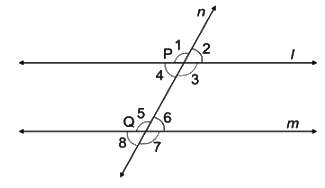
Lines l and m are parallel if any of the following is true:
- Pairs of alternate angles are equal.
∠3 = ∠5, ∠1 = ∠7 - Pairs of corresponding angles are equal.
∠2 = ∠6, ∠4 = ∠8 - The sum of the interior (or exterior) angles on the same side of the transversal is 180°.
∠3 + ∠6 = 180° or
∠1 + ∠8 = 180°
Constructions of Specific Angles
(i) Draw a ray OA
(ii) Using a compass, with O as centre and any radius draw an arc PQ which cuts OA at P
(iii) With P as centre and same radius draw an arc to cut the arc PQ at R
(iv) Join OR and produce it to form the ray OB
(v) The ∠AOB thus formed measures 60°.
Note: To get angle of 30°, follow the above steps and then draw a angle bisector.
(i) Draw a ray OA
(ii) With O as centre and any radius draw an arc which cuts OA at P
(iii) With P as centre and same radius draw an arc to cut the arc in step (ii) at W
(iv) With Q as centre and same radius as in step (ii) draw an arc to cut the arc in step (ii) at R
(v) With Q as centre and same radius draw an arc
(vi) With R as centre and same radius draw an arc, to cut the arc in Step (v) at C
(vii) Join OC and produce it to B
(viii) The ∠AOB thus formed measures 90°
Note: To get angle of 45º, follow the above steps and then draw a angle bisector
To get angle 120°, follow steps (i) to (iv) above, and join OR and produce it to B.
Drawing a Perpendicular Bisector
(i) Draw a line segment AB of given length by using a scale

(ii) With A as centre and radius more than half of AB, draw arcs on each side of AB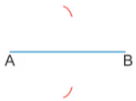 (iii) With B as centre and same radius, repeat step (ii)
(iii) With B as centre and same radius, repeat step (ii)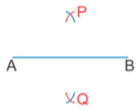 (iv) Join line segment PQ, which is a perpendicular bisector to AB
(iv) Join line segment PQ, which is a perpendicular bisector to AB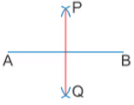
Drawing an Angle Bisector
(i) With A as centre and any radius, draw an arc cutting AB at P and AC at Q
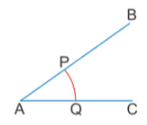
(ii) With P as centre and radius more than half of PQ, draw an arc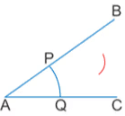 (iii) With Q as centre and same repeat step (ii)
(iii) With Q as centre and same repeat step (ii)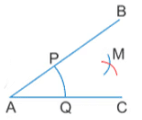 (iv) Join AM and produce it to AR. The ray AR is bisector of ∠BAC
(iv) Join AM and produce it to AR. The ray AR is bisector of ∠BAC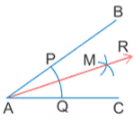
The document Revision Notes: Properties of Angles and Lines - Including Parallel | Mathematics Class 6 ICSE is a part of the Class 6 Course Mathematics Class 6 ICSE.
All you need of Class 6 at this link: Class 6
|
44 videos|202 docs|24 tests
|
Related Searches




















